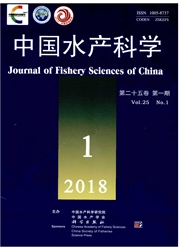

 中文摘要:
中文摘要:
为了解鳊鲂鱼类及其杂交子代的生长状况及形态差异,对鲂属(Megalobrama)团头鲂(AA)、三角鲂(TT),鳊属(Parabramis)长春鳊(PP)自交群体及其杂交子代(AT、TA、AP和PA)共7个群体进行了生长对比,并运用多元统计方法对繁殖后代的生长性状、可数性状、可量性状和框架性状的形态学差异进行分析。在实验组1中,AA绝对增重率最高(0.36 g/d),分别是TT(0.15 g/d)、AT(0.30 g/d)和TA(0.27 g/d)的2.4倍、1.2倍和1.3倍,且AT和TA绝对增重率显著高于TT(P〈0.05)。在实验组2中,AA绝对增重率显著高于其他组(P〈0.05),分别是PP(0.14 g/d)、AP(0.17 g/d)和PA(0.15 g/d)的1.7倍、1.4倍和1.6倍。结果表明,团头鲂(AA)的生长速度显著快于三角鲂(TT)和长春鳊(PP)自交群体(P〈0.05),AT、TA、AP和PA这些杂交后代的生长速度基本介于双亲之间,即低于团头鲂而高于三角鲂或长春鳊。对9项可量性状和20项框架参数的聚类分析结果表明,杂交后代的主要形态特征较为接近母本,即TA与TT的亲缘关系较近,AT和AP与AA的亲缘关系较近,PA与PP关系较近。对7个群体进行判别分析,结果显示其综合判别率为86.30%。主成分分析获得了表示形态差异的3个主成分,其累计贡献率为95.81%,主成分1特征向量绝对值较大的各性状大多集中在鱼体的纵轴,即背腹轴方向,而主成分2性状大多集中在尾部,反映了尾部的体型特征。本研究为鳊鲂鱼类的杂交育种以及种质鉴别提供了基础资料。
 英文摘要:
英文摘要:
In the present study, growth rates of Megalobrama amblycephala (AA), M. terminalis (TT), Parabramis pekinensis (PP), and their hybrids (AT, TA, AP, and PA) were compared to investigate growth and morphological differences. Three multivariate morphometric analyses were conducted to assess morphological variations based on meristic parameters, measurable scaling parameters, and truss network scaling parameters. In the first group, absolute weight gain rates of AT and TA were significantly greater than that of TT but were all lower than that of AA (0.36 g/d) (P〈0.05). Growth rate of AA was 2.4, 1.2, and 1.3 times that of TT (0.15 g/d), AT (0.30 g/d), and TA (0.27 g/d), respectively. In the second group, the absolute weight gain rate of AA was also the largest (0.24 g/d), which was 1.7, 1.4, and 1.6 times greater than that of PP (0.14 g/d), AP (0.17 g/d), and PA (0.15 g/d), respectively. The growth rate of AA was significantly faster than that of TT and PP (P〈0.05), and the growth rate of their hybrid offspring was between that of their parents; lower than that of AA, but higher than that of TT or PP. In addition, no differences in countable characters were detected among the seven groups (P〉0.05). Based on the nine measurable scaling parameters and 20 truss network scaling parameters, a cluster analysis revealed that the hybrids were closer to their female parent than to their male parent; namely, the relationships with TA and TT were closer than the relationships with AA, AT, AP, and PA. A discriminant analysis using the morphological characteristics of the seven breeding groups was carried out, resulting in a high comprehensive discriminant rate of 86.30%. A principal component analysis (PCA) showed that three main PCs were obtained with a cumulative contribution rate of 95.81% of total variation, which represented the major morphological variation in the seven breeding groups. Furthermore, traits with a larger feature vector absolute value for
 同期刊论文项目
同期刊论文项目
 同项目期刊论文
同项目期刊论文
 期刊信息
期刊信息
